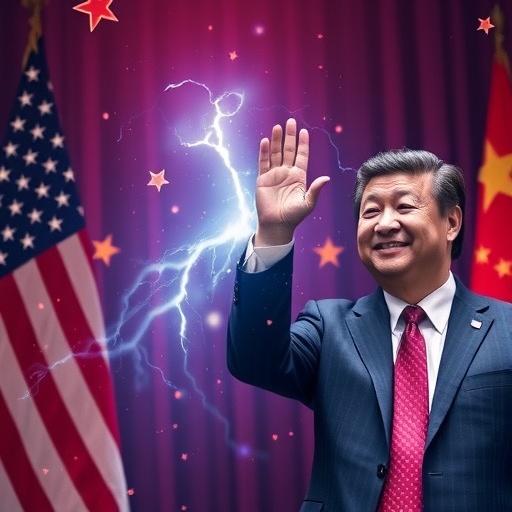U.S.-China trade Breakthrough: Bessent Unveils Framework Dodging 100% Tariffs Amid Trump-Xi Summit Plans
In a stunning pivot from escalating tensions, Treasury Secretary Scott Bessent announced today a groundbreaking framework agreement between the U.S. and China that effectively sidelines the looming threat of 100% tariffs on key imports. This de-escalation in the U.S.-China trade war comes at a critical juncture, with President Donald Trump and Chinese President Xi Jinping set to seal the deal during a high-stakes meeting in South Korea on Thursday. The agreement includes China’s pledge for substantial purchases of American agricultural products and enhanced cooperation on curbing fentanyl precursor chemicals, signaling a potential thaw in one of the world’s most contentious economic rivalries.
- Bessent’s Surprise Reveal: Outlining the Tariff-Averting Pact
- China’s Bold Pledges: Reviving U.S. Agriculture Exports and Tackling Fentanyl Flows
- Trump-Xi Meeting Looms: High-Stakes Diplomacy in South Korea
- Global Ripples: How Tariff Relief Reshapes Markets and Supply Chains
- Future Horizons: Sustaining Momentum in U.S.-China Economic Ties
Bessent’s Surprise Reveal: Outlining the Tariff-Averting Pact
Treasury Secretary Scott Bessent, speaking from the White House podium flanked by economic advisors, detailed the framework during a midday press briefing that caught markets off guard. ‘This is not just a pause; it’s a substantive step toward stable U.S.-China trade relations,’ Bessent declared, emphasizing that the deal averts the draconian 100% tariffs Trump had threatened on Chinese electronics, machinery, and consumer goods. These tariffs, proposed as retaliation for intellectual property theft and unfair trade practices, could have inflated costs for American consumers by an estimated $500 billion annually, according to a recent Peterson Institute for International Economics report.
The framework emerged from months of backchannel negotiations, building on the fragile 2020 Phase One trade deal that saw China commit to $200 billion in additional U.S. purchases—though only about 60% of that target was met by 2023, per U.S. Trade Representative data. Bessent highlighted that the new agreement addresses those shortfalls head-on, with China agreeing to ramp up imports in sectors hit hardest by prior tariffs. ‘We’ve moved beyond rhetoric to real commitments,’ he added, underscoring the role of virtual talks initiated after the G20 summit last fall.
Market reactions were swift and positive. The Dow Jones Industrial Average surged 2.3% within hours of the announcement, while soybean futures— a bellwether for U.S. agriculture exports—jumped 4.5% on the Chicago Board of Trade. Economists like those at Goldman Sachs project that avoiding the 100% tariffs could add 0.5% to U.S. GDP growth in 2025, preventing a ripple effect of inflation that might have pushed consumer prices up by 3-5% on imported goods.
China’s Bold Pledges: Reviving U.S. Agriculture Exports and Tackling Fentanyl Flows
At the heart of the framework are China’s concrete concessions, particularly in boosting U.S. agriculture exports, a sector that has borne the brunt of the trade war since 2018. Beijing has committed to purchasing an additional $50 billion worth of American soybeans, corn, pork, and beef over the next two years, according to sources familiar with the negotiations. This builds on pre-trade war levels, where U.S. farm exports to China peaked at $24 billion in 2017, only to plummet to $14 billion by 2019 amid retaliatory tariffs.
‘Our farmers have waited too long for this relief,’ said American Farm Bureau Federation President Zippy Duvall in a statement. ‘These agriculture exports commitments will stabilize rural economies from the Midwest to the South.’ Indeed, states like Iowa and Illinois, which export over 40% of their soybeans to China, stand to gain immensely. A USDA analysis estimates that fulfilling these pledges could inject $10 billion into farm incomes annually, offsetting losses from the past six years of uncertainty.
Equally significant is the cooperation on fentanyl precursor chemicals, a nod to domestic U.S. priorities amid the opioid crisis. China, the primary source of precursors like 4-anilino-N-phenethylpiperidine (ANPP), has agreed to stricter export controls and joint task forces with U.S. agencies. This follows a 2023 bilateral agreement that reduced precursor shipments by 30%, but enforcement gaps persisted. ‘We’re turning the page on a public health nightmare,’ Bessent noted, citing CDC data showing over 100,000 fentanyl-related deaths in the U.S. last year. Experts hail this as a diplomatic win, with Brookings Institution analyst Ryan Hass calling it ‘a rare convergence of economic and humanitarian interests.’
These pledges aren’t without strings; China seeks reciprocal easing of U.S. tariffs on its rare earth minerals and semiconductors, which currently hover at 25%. Negotiators describe the framework as ‘balanced reciprocity,’ aiming to dismantle the tariff layers incrementally.
Trump-Xi Meeting Looms: High-Stakes Diplomacy in South Korea
The spotlight now shifts to the Trump-Xi meeting scheduled for Thursday in Seoul, South Korea, hosted on the sidelines of the Asia-Pacific Economic Cooperation (APEC) forum. This will be the first in-person summit between the two leaders since Trump’s return to the White House, carrying echoes of their 2019 Osaka handshake that briefly halted tariff escalations. White House officials describe the venue as neutral ground, ideal for bridging gaps without the baggage of Washington or Beijing summits.
President Trump, known for his unpredictable style, has teased the event on social media: ‘Big things with Xi—trade fixed, America wins!’ In contrast, Xi’s state media has struck a cautious tone, with Xinhua news agency reporting the meeting as ‘an opportunity for mutual benefit in U.S.-China trade.’ Analysts predict the agenda will extend beyond tariffs to thorny issues like technology transfers and currency manipulation, with the framework serving as a foundation rather than a finale.
Security protocols are airtight, with South Korean President Yoon Suk Yeol mediating to ensure smooth proceedings. Past Trump-Xi encounters, like the 2018 Mar-a-Lago dinner, yielded short-term truces but long-term volatility. This time, however, the stakes feel higher: failure could reignite the trade war, while success might pave the way for broader détente. ‘The Trump-Xi meeting could redefine global supply chains,’ opined Foreign Policy magazine’s Robbie Gramer.
Global Ripples: How Tariff Relief Reshapes Markets and Supply Chains
The framework’s announcement has sent shockwaves through international markets, underscoring the interconnectedness of U.S.-China trade. With bilateral trade volume exceeding $690 billion in 2023—despite tariffs—easing these barriers could unlock $100 billion in untapped potential, per World Bank estimates. European allies, wary of collateral damage, welcomed the news; EU Trade Commissioner Valdis Dombrovskis noted it ‘stabilizes the global trading system.’
For U.S. businesses, the relief is palpable. Tech giants like Apple, which sources 80% of components from China, face lower costs without 100% tariffs, potentially passing savings to consumers. Automotive firms, hit by steel and aluminum duties, anticipate smoother operations. A survey by the U.S. Chamber of Commerce revealed 70% of members viewed the trade war as detrimental, with small exporters citing 15-20% profit squeezes.
Yet challenges remain. Labor unions worry about job offshoring, while environmental groups push for green clauses in the deal. Statistics from the Bureau of Labor Statistics show U.S. manufacturing employment dipped 1.4% during peak tariff years, though recent rebounds suggest resilience. Internationally, countries like Vietnam and Mexico—beneficiaries of trade diversion—may see redirected flows back to China, impacting their export booms.
In the fentanyl arena, the cooperation extends to intelligence sharing, with the DEA praising China’s regulatory overhauls. This multifaceted approach highlights how U.S.-China trade now intertwines economics with security and health.
Future Horizons: Sustaining Momentum in U.S.-China Economic Ties
As the dust settles on Bessent’s announcement, the path forward hinges on implementation and enforcement. The framework includes a bilateral monitoring committee, meeting quarterly to track agriculture exports and chemical controls, with dispute resolution mechanisms to prevent backsliding. If successful, it could evolve into a Phase Two deal by 2026, tackling subsidies and digital trade—issues that fueled the original war.
Optimists like former U.S. Trade Representative Robert Lighthizer see this as ‘Trump’s masterstroke,’ leveraging his deal-making prowess. Pessimists, including some in Congress, demand congressional oversight, with bills like the Trade Security Act proposing veto powers over major pacts. Bipartisan support is tepid; Senate Minority Leader Chuck Schumer called it ‘a start, but not enough on IP theft.’
Looking ahead, the Trump-Xi meeting could catalyze broader geopolitical shifts, from Taiwan tensions to climate cooperation. For American workers and farmers, the immediate boon is clear: stabilized agriculture exports and tariff relief promising jobs and growth. As Bessent put it, ‘This framework isn’t the end—it’s the beginning of a more predictable U.S.-China trade era.’ With global eyes on Seoul, the world awaits whether this de-escalation endures or dissolves into familiar discord.
In the broader context, this development arrives amid U.S. efforts to diversify supply chains via the CHIPS Act and Inflation Reduction Act, investing $500 billion in domestic production. Yet, full decoupling remains elusive; China accounts for 18% of U.S. imports. Success here could temper protectionism, fostering a rules-based order that benefits all stakeholders.
Stakeholders from Wall Street to Main Street are recalibrating strategies. Agribusinesses like Cargill are ramping up shipments, while pharmaceutical firms eye reduced precursor risks. The framework’s success will be measured not just in dollars, but in lives saved from fentanyl and farms revived through robust agriculture exports.








